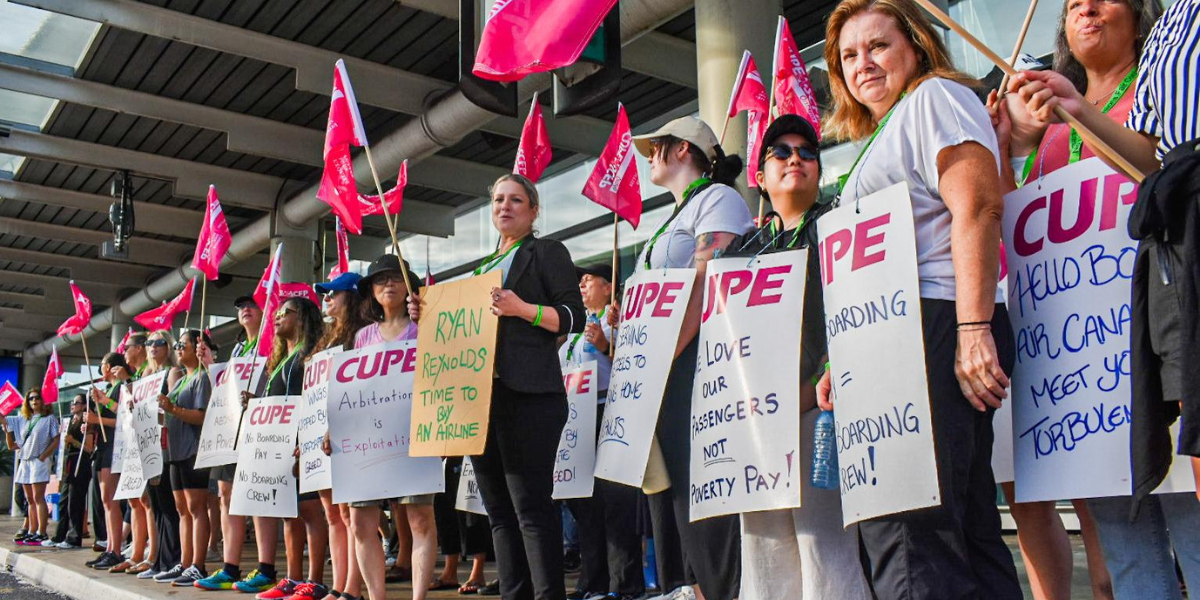Less than twelve hours after Air Canada flight attendants began picketing on Saturday, August 16, the Carney government moved to impose binding arbitration on 10,500 workers. The order came despite an overwhelming 99.7 percent strike mandate on a 94.6 percent turnout — a show of support that left no ambiguity: flight attendants are determined to win fair wages and an end to unpaid work.
Rather than resolve the conflict, the government’s order awoke a sleeping giant. On August 17, coordinated pickets and rallies took place in Toronto, Montreal, Calgary, and Vancouver, where flight attendants stood openly against the order. Their message was clear: they will not accept poverty wages, unpaid labour, or the silencing of their collective voice.
Flight attendants stood in defiance of the government’s decree, joined on the picket line by leaders and members from CUPE, UNIFOR, OPSEU, COPE, ETFO, the International Association of Machinists, the Teamsters, and the International Brotherhood of Electrical Workers. Their presence signalled more than solidarity — it marked a clear line in the sand. The Carney government’s intervention crossed that line, and flight attendants responded by declaring they will not back down.
Unpaid work won’t fly
At the centre of the dispute lies a system of poverty wages and entrenched unpaid work. Flight attendants are only compensated when planes are in the air. Hours spent boarding passengers, conducting federally mandated safety checks, assisting with medical emergencies, or waiting at gates are unpaid. CUPE surveys show attendants effectively give away an additional week of labour each month. Nearly all respondents reported unpaid time while disembarking passengers or waiting between flights; three-quarters said they received only partial pay for mandatory training.
Because most flight attendants are women, this structure reinforces the gender pay gap while padding Air Canada’s bottom line. CUPE argues the arrangement “subsidizes the company’s profits at the expense of frontline workers.” Even for paid hours, wages have failed to keep pace with inflation. Entry-level attendants have seen only a $3 per hour increase since 2000, while inflation has risen nearly 70 percent. When unpaid hours are included, new attendants earn less than the federal minimum wage annually.
Meanwhile, executive pay has surged. Last year, CEO Michael Rousseau collected nearly $12.5 million in compensation.
Employer abandons the table
The flight attendants’ contract, which expired earlier this year, has been a growing source of frustration. At the centre of the dispute is Air Canada’s refusal to pay workers for all the hours they are on the job. Flight attendants spend an average of 35 hours each month performing unpaid duties—boarding passengers, conducting safety checks, waiting at the gate—labour essential to the airline’s operations.
CUPE pressed for wages that cover every hour worked, not just time in the air. Air Canada responded with a headline figure of a 38 percent increase over four years, but this proposal left the core issue untouched: it continued to deny full pay for ground duties. For many workers, especially those earning entry-level wages, the deal would still amount to poverty wages once inflation and unpaid hours are taken into account.
The flight attendants’ contract, long expired, has been a source of mounting frustration. Bargaining reached a critical point this summer as unpaid work remained unresolved. On August 11, 2025, the union submitted a revised wage proposal, which included the withdrawal of its long-standing position seeking the same wage adjustment previously provided by Air Canada to its pilots. The following day, CUPE offered further modifications. Rather than engage, Air Canada refused to respond meaningfully and soon declared an impasse, pressing the government to intervene.
Lessons from education workers
Flight attendants’ defiance takes place in a broader context of labour pushback against government overreach. In 2022, Ontario education workers staged a province-wide strike after the Ford government used back-to-work legislation and the notwithstanding clause to strip their bargaining rights.
The workers’ refusal to comply shifted the entire balance of power. Pickets went up across the province, classrooms closed, and public opinion swung hard against the government. Within days, Ford repealed the legislation and reopened the bargaining process. The lesson was unmistakable: governments can legislate away rights on paper, but only organized worker action determines whether those laws hold in practice.
Flight attendants now confront a federal government reaching for the same playbook. Arbitration was designed to sideline their strike mandate, yet it has instead pushed thousands of workers into open confrontation. Education workers proved that rights are defended on the picket line, not in courtrooms or through hollow political promises. Flight attendants are now showing that real gains are only won when workers themselves take action.
A showdown between Carney and flight attendants
The government hoped arbitration would end the conflict quietly. Instead, it revealed how little weight Ottawa places on democratic mandates when they come from workers. Flight attendants have shown they will not accept another decade of poverty wages and unpaid hours. And they have shown that when governments interfere to shield profitable corporations, workers will resist.
What began at Pearson, Montreal, Calgary, and Vancouver is only the opening chapter of this fight. The Carney government has chosen to stand with Air Canada executives rather than the thousands who keep the airline running. That alliance of state power and corporate profit is now laid bare — and it is precisely what flight attendants are challenging every time they hold the line.
Did you like this article? Help us produce more like it by donating $1, $2, or $5. Donate

